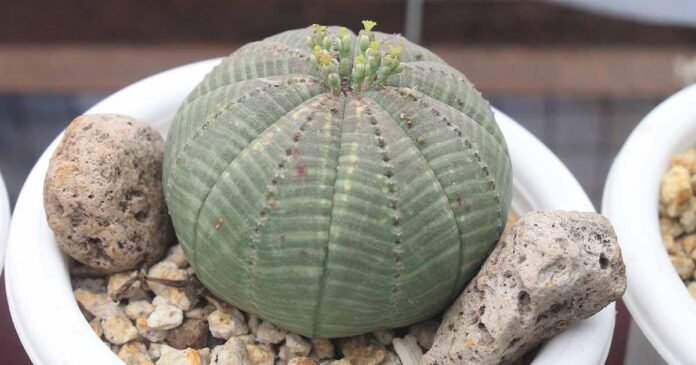Euphorbia obesa
If you’re a succulent fan, you’ll want to get to know the baseball plant, Euphorbia obesa.
As the common name suggests, this plant resembles the signature object of America’s favorite pastime – the baseball, with a few botanical embellishments.
Also called sea urchin plant for its resemblance to the marine creature, this species is native to the Cape Province region of South Africa, particularly the Great Karoo semi-arid desert basin.

We link to vendors to help you find relevant products. If you buy from one of our links, we may earn a commission.
Baseball plant has a leafless fleshy stem adept at storing water to sustain itself in one of the world’s harshest climates.
But Mother Nature didn’t just endow the smooth, green globe with function.
The vertical ridges resemble stitches, intersecting horizontal pinkish-purple markings that show best in full sun, for a tartan-like appearance. And it’s topped off with a crown of tiny greenish-yellow springtime blossoms.
The flowers are nondescript but unique because they may be male, with pollen-coated anthers, or female, with stigmas.
And while rare, a single plant may have both male and female flowers, and the gender may change over the years.
Our guide to growing euphorbia provides an overview of the genus. This article focuses on the unique characteristics of E. obesa.
Here’s what we’ll cover:
The baseball plant has a taproot and grows a single globe. As it ages, the stem elongates into an egg-shaped or cylindrical column.
Mature dimensions are six to eight inches tall with a spread of three to four inches. Brown, bark-like “cork” at the base is a natural part of the maturation process.


In addition to the primary species, there is a subspecies, E. obesa subsp. symmetrica, that is spherical, but flattened, rather than columnar.
If you are a cactus aficionado, you may notice that this subspecies resembles the sand dollar cactus, Astrophytum asterias, endemic to Texas and Mexico. It has similar care requirements.
Quick Look
Common name(s): Baseball euphorbia, baseball plant, living baseball, sea urchin plant
Plant type: Succulent
Hardiness (USDA Zone): 9-11 (outdoors)
Native to: Karoo regions of Cape Province, South Africa
Bloom time / season: Spring and summer
Exposure: Full to partial sun, bright, indirect light indoors
Soil type: Loose, sandy loam, well-draining
Soil pH: 5.0-8.0, slightly acidic to slightly alkaline
Time to maturity: 5 years
Mature size: 6-8 inches tall by 3-4 inches wide
Best uses: Container, houseplant, small-scale rock garden, xeriscape
Taxonomy
Order: Malpighiales
Family: Euphorbiaceae
Genus: Euphorbia
Species: Obesa
You’ll find attractive placements for baseball plants outdoors in small-scale xeriscapes, such as rock gardens, where water-wise, low-maintenance flora creates a virtually self-sustaining growing environment.


